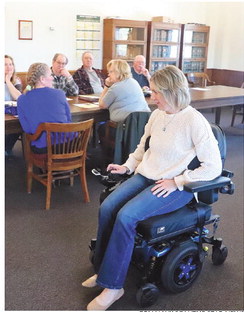Electors keep Medford school tax rate stable at $8.33
BY BRIAN WILSON NEWS EDITOR
Medford schools got a boost from increased participation in the summer school program.
At Monday night’s school district annual meeting, finance director Audra Brooks reported that strong summer school numbers helped boost the district’s total enrollment amount by the equivalent of 34 students. Districts receive state aid based on their total enrollment, according to Brooks, they are able to count summer school attendance at a rate of 40% full time equivalent. This is significantly up from previous years thanks in part to an overhaul and lengthening of the program this past summer.
According to Brooks, the district’s third Friday in September enrollment, including the summer school total, was at 2,111.
Brooks presented the financial overview of the district and the 2019-2020 budget. The budget includes $28,691,822 in both projected revenue and expenses. This represents an overall increase of about 6.11% over the prior year. The bulk of the budget revenue comes from state and federal sources accounting for 60% of the budget, with open enrollment bringing in about 10% of the revenue for the district. The local property tax levy accounts for about 21% of total district revenues. This year the district’s property levy is $7,660,328 which is up about $400,000 from last year.
However, due to growth in the district’s equalized value, the projected tax rate will remain steady at $8.33 per $1,000 of equalized value. What this means is that the owner of a $100,000 property will pay about $833 in school taxes this year.
Medford’s tax rate remains lower than many of the surrounding districts.
District resident Jenny Shipman asked why Medford was so much lower than the surrounding districts.
“We are very fiscally responsible,” Brooks replied, noting that the district works to control spending. The district also benefits from having a growing tax base.
Resident Bryan Bormann questioned the amount of employees in the district and how many are in administration. District administrator Pat Sullivan replied that the number of administrators has remained steady for a number of years at 10. The district has a total of 340 employees which includes teachers, aides, support staff and custodians. The fastest growing area of employment within the district is in the Rural Virtual Academy (RVA) which is a direct result of the RVA’s steady student enrollment.
In other annual meeting business, residents:
★ Approved granting the school board the authority to buy and sell property and to lease buildings. The district leases the Taylor County Education Center as well as a building in Mosinee for use by the RVA and other programs.
★ Approved opening a $7.5 million line of credit for the 2019-2020 school year. This is about $1.5 million more than the line of credit approved last year. This is a cash-flow tool for the district to cover expenses in between receiving property taxes, aid payments and other revenues. The interest rate is about 4% with the district only paying on funds that are used. “This is probably more than we need,” Brooks said. However she wanted to not be conservative in estimating the amount needed to avoid having to come back and ask for additional funds if there is a shortfall. She also noted that the district spent money from its fund balance last year reducing the amount available to help with cash flow.
★ Approved keeping the per meeting pay for the board members the same as in previous years at $100 per meeting for president, $95 per meeting for the clerk and $75 per meeting for other members. In addition all members receive $45 per meeting for committee meetings they are assigned to.






